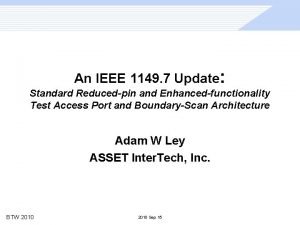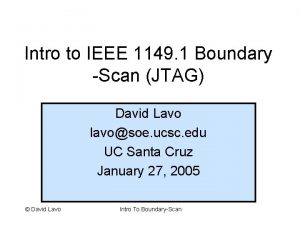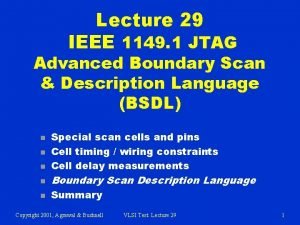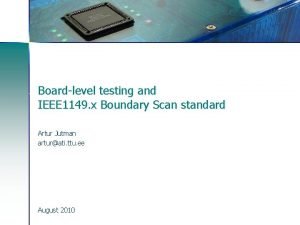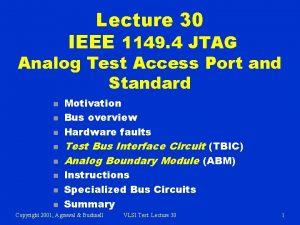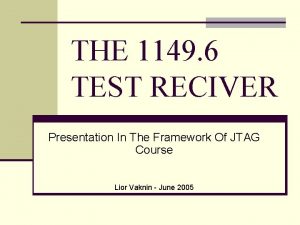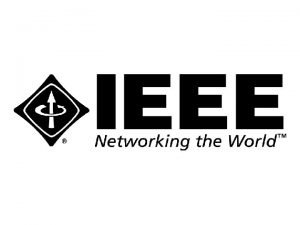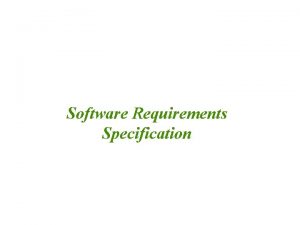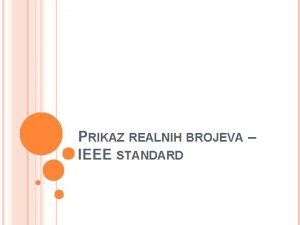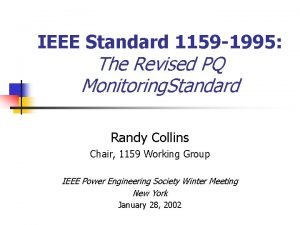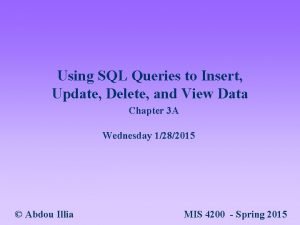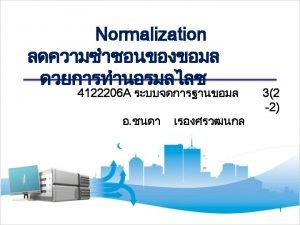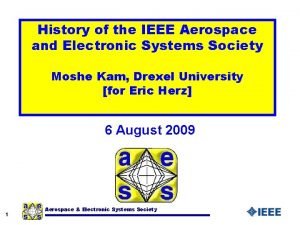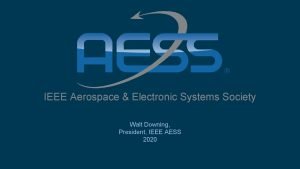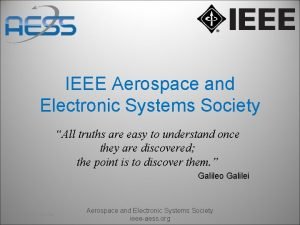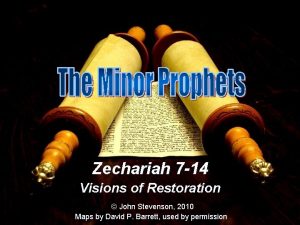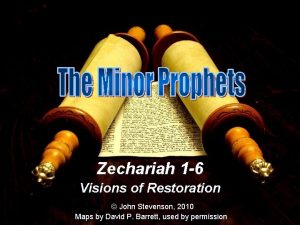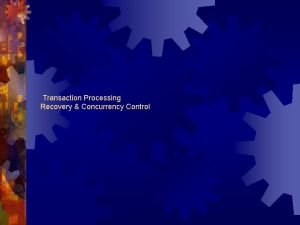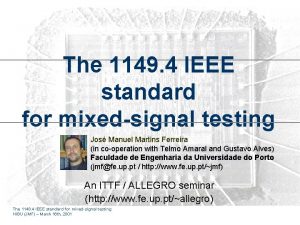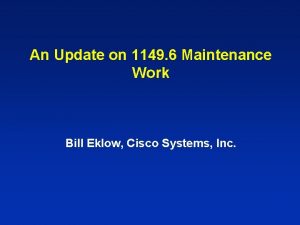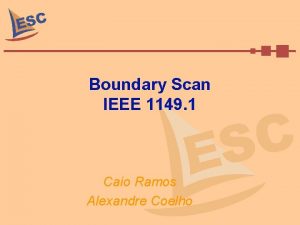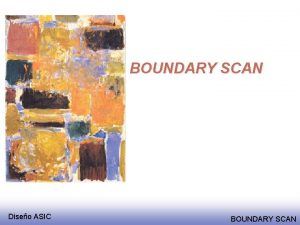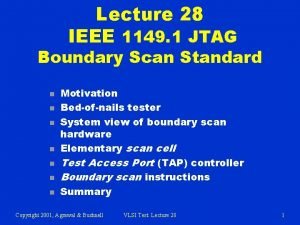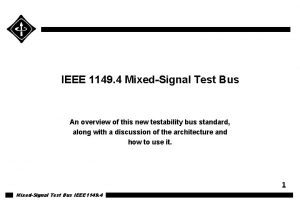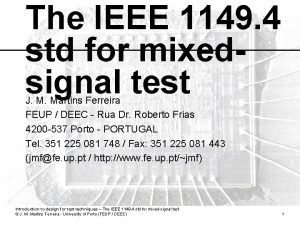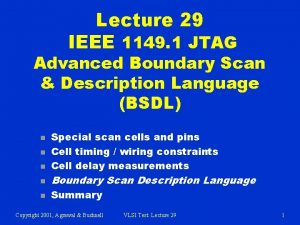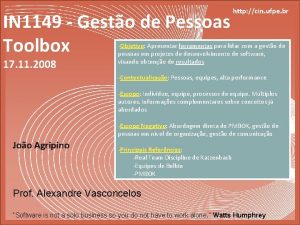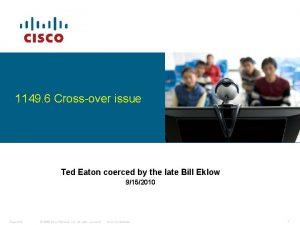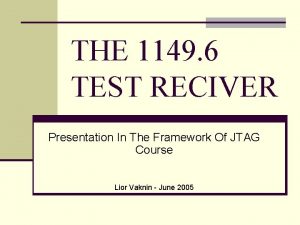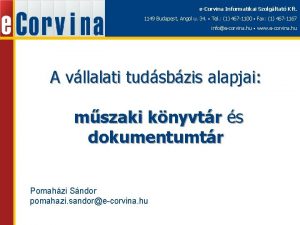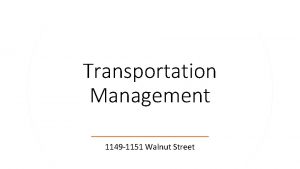An IEEE 1149 7 Update Standard Reducedpin and




























- Slides: 28

An IEEE 1149. 7 Update: Standard Reduced-pin and Enhanced-functionality Test Access Port and Boundary-Scan Architecture Adam W Ley ASSET Inter. Tech, Inc. BTW 2010 Sep 15

Acknowledgements Ø the P 1149. 7 working group Ø Stephen Lau of Texas Instruments Ø Gary Swoboda of Texas Instruments • who shall be recognized as the technical architect and principal author of 1149. 7 BTW 2010 2

Outline Ø What is IEEE 1149. 7? Ø IEEE 1149. 7 Key Objectives Ø How it Works • Selection Hierarchy • Capability Classes BTW 2010 3

What is IEEE 1149. 7? BTW 2010

What is IEEE 1149. 7 ? Ø Formally, Standard for Reduced-pin and Enhancedfunctionality Test Access Port and Boundary-Scan Architecture BTW 2010 6

What is IEEE 1149. 7 ? Ø NOT a replacement for IEEE 1149. 1 • rather, an adaptation and extension of it, built upon it’s foundation and legacy Ø Preserves • the original Boundary-Scan Architecture - particularly for use in test and in-system configuration Ø Maintains compatibility with the standard Test Access Port while offering • Reduced Pin Count - absolute minimum of 2 pins (down from 4) • Enhanced Functionality - particularly for use in applications debug BTW 2010 7

What is IEEE 1149. 7 ? Ø Scope • Link between 1149. 1 -based Debug and Test Systems and Target Systems • Additional layer adapts for new functionality and features • Link behavior includes timing, protocols, and functionality of the adapters • Does not modify or create inconsistencies with IEEE 1149. 1 (JTAG) • A compliant superset the IEEE 1149. 1 Ø Status • Formally adopted by IEEE-SA Standards Board 2009 Dec • Published by IEEE on 2010 Feb 10 Ø Sightings • Adopted by MIPI and NEXUS 5001 • Design and Validation support from IPextreme and Globetech • Semiconductor support announced by TI, Freescale, ST BTW 2010 8

Adaptation of 1149. 1 to 1149. 7 “before” “after” 1149. 7 chip 1149. 1 IC BTW 2010 1149. 7 adapter 11 1149. 1 “core”

IEEE 1149. 7 Key Objectives BTW 2010

IEEE 1149. 7 Key Objectives Ø For Test • Maintain compliance with 1149. 1 to preserve the industry test infrastructure Ø For Applications Debug • Extend/ Advance capability to provide: - Reduced Power Modes – Defined test logic power down - Improved Performance – Shortened multi-chip chains – Glueless “star” configuration - Reduced Pins - Links to “Instrumentation” BTW 2010 13

Star topology for a 3 -die SIP Si. P Through-silicon vias die 3 die 2 die 1 TCKC BTW 2010 TMSC 14

How it Works BTW 2010

Conventional series topology - highlighting the star wiring for TCK/TMS TDI TCK TMS TDO BTW 2010 16

Notional view of the 1149. 7 architecture TAP. 7 n. TRST TCK(C) TMS(C) TAP. 7 Controller RSU APU EPU TDI(C) TDO(C) PSL Reset and Selection Unit Advanced Protocol Unit Pin Sharing Logic Extended Protocol Unit System BTW 2010 Test Logic 17 STL

Selection Hierarchy Ø Technology • Where the 1149. 7 technology can be placed offline, the TAP. 7 signaling can be shared with other technologies Ø Topology • Where the constituent 1149. 7 devices can be placed offline (a function required for T 3 and above), the TAP. 7 signaling can be shared among any topology branches, whether series, star-2, or star-4 Ø Adapter (i. e. , ADTAPC) • 1149. 7 devices comprising a selected topology branch will share TAP. 7 signaling and, where the topology branch is star-2 or star-4, a given device may be selected for a given operation Ø Chip (i. e. , CLTAPC) • For a selected ADTAPC, the CLTAPC may be offline and will require selection when it must be operated Ø Core (i. e. , EMTAPC) • For a selected CLTAPC, given EMTAPC(s) of interest may be offline and will require selection when it (they) must be operated BTW 2010 19

Key Features of the Capability Classes Ø Six classes of 1149. 7 test access ports (TAP. 7 s), T 0 - T 5 Ø Incremental capability, each higher builds upon the lower Ø Class T 0 – foundation • 1149. 1 behavior from start-up, even where multiple on-chip TAPs Ø Class T 1 – commands and registers • common debug functions, features to minimize power consumption Ø Class T 2 – scan formats • improved scan performance, optional hot-connection capability Ø Class T 3 – direct addressability • operation in four-wire Series or Star Scan Topology Ø Class T 4 – packetization of scan data (2 -pin scan formats) • two-pin or four-pin interface; two-pin operation serializes 1149. 1 transactions and provides for higher test clock rates Ø Class T 5 – transport of non-scan data (2 -pin mode) • data transfers concurrent with scan, utilization of functions other than scan, and control of TAP. 7 pins for custom debug technologies BTW 2010 21

IEEE 1149. 7 hierarchy of classes BTW 2010 22

T 1, TAP FSM trajectories for Zero-Bit Scans 1 Test-Logic. Reset 0 Run-Test-Idle Select-DRScan 0 1 Select-IRScan 0 1 1 Capture-DR Capture-IR 0 0 Shift-DR 1 Exit 1 -DR b 0 Pause-DR 1 0 Exit 2 -DR Shift-IR 0 1 1 a BTW 2010 0 28 1 0 Pause-IR 0 1 0 Exit 2 -IR 1 Update-DR 0 Exit 1 -IR 1 1 1 Update-IR 1 0 0

T 1, Zero-Bit Scans Create Control Levels Key: • Count the number of Zero-Bit -Scans (ZBS) to change the definition of BYPASS instruction. 1…. 2…. Lock Control Level at 2. IR Register BTW 2010 BYPASS 29 • Lock control level when the Shift-DR state is reached.

T 1, Commands & Registers Ø Accepted at Control Level 2 Ø Controller commands are 10 -bit values. They consist of 2 consecutive DR scans while the controller is locked at control level 2. Ø Command Part 1 (CP 1) provides the command Ø Command part 2 (CP 2) provides the immediate operand or lower 5 bits of the command Ø Can create a three-part command • Can send/receive data values other than values embedded in CP 2. • Crated by appending an additional DR Scan after the CP 1 and CP 2 to transport a data value. BTW 2010 1 st DR Scan 2 nd DR Scan 3 rd DR Scan creates Access an EPU scan path 5 -bit op-code 5 -bit operand X bits CP 1 CP 2 2 part Command 30 3 part Command

T 2, Scan Formats Ø Adds 3 Scan Formats: Change the operation of scan • JSCAN 0: Provides compliant IEEE 1149. 1 operation • JSCAN 1: Provides “Hot” connection and disconnection protection • JSCAN 2: Improved performance for Series connected devices. • Write only register is used to specify the scan format Ø These 3 formats use two features: • Chip Level Bypass • TAP Selection BTW 2010 32

T 3, Star-4 Topology TCK(C) TMS(C) TDIC TDOC BTW 2010 34

T 3, Elements of the TAP. 7 Controller Address (TCA) MSB LSB 34 27 26 NODE_ID[7: 0] BTW 2010 11 10 DEVICE_ID[27: 12] Part Number 35 00 DEVICE_ID[11: 0] Manufacturer

T 4, Scan packet serialization, OScan 1 TCKC TMSC n. TDI TMS TDO state BTW 2010 38

T 4, Scan packet serialization, OScan 7 TCKC TMSC n. TDI n. TDI Shift-x. R state BTW 2010 39

T 5, Transport Ø Transport packet type is added to support: • Background Data Transfers (BDX) • Custom Data Transfers (CDX) Ø When BDX is enabled: • • During link IDLE time, instrumentation data is transmitted Transport packets are attached to the IDLE, PAUSE, or UPDATE states DTC to target, target to DTC , Bi-Directional or custom transfers Non-scan data is transferred (ex: instrumentation data) Ø When CDX is enabled: • Instead of SCAN, an alternate protocol is allowed to use the link during SHIFT-DR TAP states • Transport packets are attached to the IDLE, PAUSE, or UPDATE states • Custom transfers on a clock by clock basis • Non-scan data is transferred BTW 2010 41

Conclusion Ø IEEE 1149. 7 is a complementary superset of IEEE 1149. 1 (JTAG) • Reduced pins and enhanced functionality Ø Built on the foundation of 1149. 1 • rapid adoption possible/ expected Ø Compatibility for test Ø Interfacing multiples • cores on SOC • die in SIP • packages for POP Ø Debug improvements • • • BTW 2010 hot-plug immunity power management optimization of scan throughput access to debug instrumentation access to custom debug technologies 52

Further Discussion Ø Where have you seen 1149. 7 chips on your boards? Ø Where will you see 1149. 7 chips on your boards? Ø Where would you like to see 1149. 7 chips on your boards? BTW 2010 53
 Ieee 1149
Ieee 1149 Jtag state diagram
Jtag state diagram Jtag 1149
Jtag 1149 Ieee 1149.x
Ieee 1149.x Database backup and recovery techniques
Database backup and recovery techniques Sba 10 tab checklist
Sba 10 tab checklist 1149/4
1149/4 Unicef/hq03-1149/senad
Unicef/hq03-1149/senad 1149/6
1149/6 00lllll
00lllll Contract management software requirements document
Contract management software requirements document Ieee 754 standard jednostruke preciznosti
Ieee 754 standard jednostruke preciznosti Ieee 1159
Ieee 1159 Ieee 802 standard
Ieee 802 standard Ieee standard 829
Ieee standard 829 The standard error of the mean
The standard error of the mean Definition of home language
Definition of home language Standard costing definition
Standard costing definition Product knowledge food and beverage service
Product knowledge food and beverage service Subjek dini sekolah menengah
Subjek dini sekolah menengah Sql queries for insert update and delete
Sql queries for insert update and delete Data redundancy and update anomalies
Data redundancy and update anomalies Transactions on aerospace and electronic systems
Transactions on aerospace and electronic systems Ieee transactions on aerospace and electronic systems
Ieee transactions on aerospace and electronic systems Ieee transactions on aerospace and electronic systems
Ieee transactions on aerospace and electronic systems Zechariah stevenson
Zechariah stevenson Zechariah stevenson update
Zechariah stevenson update University community plan
University community plan Temporary update problem in dbms
Temporary update problem in dbms
